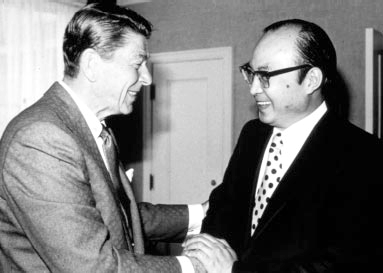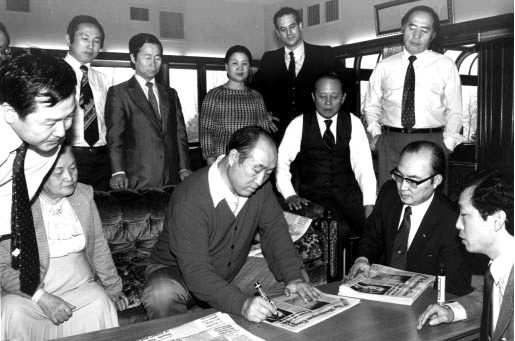
40 Years in America

|
|
40 Years in America |
|
Creating an Alternative Media Network

President Ronald Reagan and Dr. Bo Hi Pak
Unlike the unity of religion and science, the unity of religions, or even the equalization of technology and the ocean providence, the creation of a media network was not originally part of Rev. Moonís thinking or planning. Having for the most part been generously welcomed during his initial Day of Hope tours, he planned to complete the proclamation phase of his ministry with major rallies at Yankee Stadium and Washington Monument while at the same time increasing the movementís membership to 30,000 by the end of 1978. To his way of thinking, this would have been sufficient to move public opinion and push the country in the correct direction. However, it was apparent quite early that this strategy would need to be re-visited. Beginning in 1975, the print and electronic media increasingly vilified Rev. Moon. This created a climate of extreme hostility and frustrated the movementís witnessing efforts. Rev. Moon, in turn, recognized the "awesome power" of the media "to create or to destroy."
The movementís media initiatives were the direct result of its victimization at the hands of the dominant media culture. From the beginning, the movement aimed its journalistic endeavors less at self-vindication than at challenging "the supremacy of...established media that were skewing Americansí perception of the world toward the sensational, the shallow, the amoral and the political left." In this respect, the attempt was, first, to provide an alternative model of journalistic endeavor. Second, since it was unable to gain substantial enough membership to generate significant grassroots support, the movement utilized media instruments rather than large numbers of members to achieve its goals. Between 1977-85, these efforts were only partially successful. None of its newspapers sold widely, and no Unification-related media enterprise made money. In fact, they accumulated losses which eventually totaled hundreds of millions of dollars. Some of its efforts were subject to derision, and advertisers routinely withheld dollars partly due to public hostility and partly due to skepticism about subscription totals that were not audited. On the other hand, due to a happy convergence between its investments and the rise to power of a conservative Republican administration during the early 1980s, the movementís media efforts afforded it access and influence at the highest levels. The Washington Times, established by the movement in 1982 after The Washington Star folded, became the darling of the New Right and newspaper of choice in the Reagan White House.
Rev. Moon initiated the movementís first major journalistic venture on October 10, 1976, shortly after the Washington Monument rally, when he assembled a dozen or so members with journalism degrees and "set the deadline" for producing the first issue of a new daily newspaper in New York City "at December 31, 1976, the last day of the Bicentennial year." Doubtless, the symbolism of ushering in Americaís third century "with a new era of modern journalism" was compelling. Nevertheless, according to a later account, "It seemed impossible to start a daily newspaper literally from scratch, using inexperienced people, in dilapidated offices, in less than three months." Still, "second- hand desks and typewriters were purchased," and in November "the few who had journalism degrees...gave the first staff of about sixty a crash course in journalism." On December 31st, "the presses rolled early in the morning...and the first issue of The News World hit the streets of New York."
Replete with a color photograph featured each morning on the front page and a motto that described it as "New Yorkís oldest daily color newspaper," The News World was a twenty-four page general-interest daily with a staff of 200, the bulk of whom were church members. Eventually housed in the Fifth Avenue and 37th Street Tiffany Building, which the movement purchased, The News World had several "moments of glory." During the New York City blackout of 1977, "it was the only newspaper to publish, with reporters working by candlelight to write and edit stories before sending them to an upstate printing plant."
Later, during a three-month newspaper strike that shut down the cityís other major dailies, The News World continued to publish, "with its circulation soaring to nearly 400,000 daily." Undoubtedly, the paperís boldest move was to predict a "Reagan Landslide" in a bold headline on November 4, 1980, the day of the election. The next day, having been vindicated in its prediction that Reagan would "win by more than 350 electoral votes and carry New York as well," the paper published another banner headline, which read "Thank God! We Were Right!" and featured a UPI photo of President-elect Reagan holding the previous dayís News World. In 1983, The News World changed its name to the New York City Tribune, "revamped its design, cut out nonessential features, comics, and sports, and concentrated on hard news, analysis and commentary." It broke several major stories during the 1980s, including the shady real estate dealings of John Zaccaro, husband of 1984 Democratic vice presidential candidate Geraldine Ferraro. New York Mayor Ed Koch called its Commentary section the "best in the nation" and wrote a weekly column for five years.
Previously, The News World spawned a sister Spanish-language New York daily, Noticias Del Mundo on October 22, 1980. The movement also published a Korean-language daily, a Harlem weekly, and a small press service, Free Press International (FPI), out of New York. Overseas newspapers included Sekai Nippo, a daily in Japan; Ultimas Noticias, a daily in Uruguay; and the Middle East Times, a weekly published in Cyprus. Apart from print media, a movement film company, One-Way Productions, Inc., produced a feature-length motion picture, Inchon, which dramatized events surrounding the amphibious landing of U.N. troops led by General Douglas MacArthur during the Korean War. The production featured two international stars, Laurence Olivier as Douglas MacArthur, and Toshiro Mifune, as well as an all-star cast of Jacqueline Bisset, Ben Gazzara, Richard Roundtree and David Jansen. It also included such extras as 20-ton tanks, a fleet of transport convoys, an armada of Navy destroyers, jeeps, tugboats, F-86 aircraft, 1,500 soldiers and a Scottish bagpipe marching band. Logistics were a nightmare, particularly since no major film had been shot in Korea before. At a cost of nearly $50 million, Inchon was remembered as one of Hollywoodís all-time busts. Rev. Moon explained that his reasons for supporting the film did not involve "making money" but were, first, "to document the historical fact that it was the North which invaded the South," a situation that he said had been subject to persistent distortions over the past thirty years. Second, he "wanted to pay tribute to General Douglas MacArthur" whose "masterpiece of military strategy" helped preserve Korea. He also admitted to "a very personal side" behind his support in that the Inchon landing precipitated his own liberation by U.N. forces from a North Korean prison camp "just hours before I was to be taken out and executed."
For all this, the movementís media enterprises would have received scant attention or would have been accounted an oddity had it not been for Rev. Mooní decision in 1982 to launch The Washington Times in the nationís capital. There, the movement had a much stronger potential niche than in the more crowded and commercialized New York market. The Washington Star, the capitalís only major competitor of the powerful but liberal-leaning Washington Post, folded in 1981, and numerous, especially conservative voices railed against the prospect of Washington, D.C. being a "one-newspaper town." On January 1, 1982, Rev. Moon selected 200 newspaper trainees from among a full ballroom of member volunteers and directed that the Washington paper be published within two months. On the face of it, this was reminiscent of The News Worldís beginnings. However, there were significant differences. First, the movement had accumulated a great deal of experience and expertise in the intervening years. Second, and more importantly, the movement turned over the paperís editorial reins to nonmember professionals. James R. Whelan, a former editor of The Sacramento Union, was hired as the Timesí editor and publisher, and he wasted little time assembling a first-rate staff, including a number of well-known journalists...along with a sizable contingent from the defunct Washington Star. Third, the movement spared few expenses in what one commentator termed "its bid to make it in the big leagues." Start-up costs were estimated to be in the $40,000,000 to $50,000,000 range, and in 1983, the Times completed an $18,000,000 renovation of its headquarters, including a 10,000 square-foot newsroom overlooking the National Arboretum, which was regarded as "among the handsomest in the country." By 1984, the movement had invested $150,000,000 in the five-day-a-week paper.

Rev. Moon signs copies of the first edition of The Washington Times.
Although the Times was welcomed by Washington, D.C. Mayor Marion Barry and sectors of the public, it faced hazing from many quarters and was controversial from the beginning. Attention focused primarily on the matter of overt or behind-the-scenes church control. This was accentuated when James Whelan was fired. He announced at a July 17, 1984 press conference that the Times was firmly in the hands of top officials of the Reverend Sun Myung Moonís Unification movement. Whelanís charges were countered by nonmember Times officials who charged that Whelanís contentions were a cover for "managerial shortcomings" and a "loss of support among his subordinates." To some extent, these disputes overshadowed the very real influence exerted by the Times on any number of issues between 1982-85. In 1982, for example, when Reagan felt support ebbing for his tax proposals, even among Republicans, he "felt compelled" to give an exclusive interview to the Times White House correspondent as "the way to reach his political constituency." The Times, likewise, maintained a strong advocacy for Reaganís SDI initiative and was forceful in its support for the Nicaraguan resistance, launching a Nicaraguan Freedom Fund, which became national news. Along with the Timeís subsequent reporting of Soviet assistance to Nicaraguan President Daniel Ortega, its public relations offensive was instrumental in the U.S. Congress reversing its position on humanitarian aid to the Contras. The Times "highlighted Soviet human rights violations, did expansive features on the public relations and lobbying activities of left-leaning organizations...and frequently reported on the Sovietsí nuclear build-up and their sizeable military and logistic aid to national liberation movements in Asia, Latin America and Africa. Alex Jones of The New York Times called The Washington Times the "third most-quoted newspaper in America" after only The Washington Post and The New York Times and reported that "AP cited the Times in more than 80 major dispatches from D.C." during the first five months of 1985.
World Media Conferences, which the movement sponsored annually from 1978, and "fact-finding tours" which it ran were additional components of the movementís media network. The World Media Conferences were similar to ICUS and other movement-sponsored conferences in format. However, they evolved from gatherings of media scholars to meetings of working journalists. The first several were held in New York and dealt with threats to media freedom. Between 1982-84, they were convened in Seoul, Korea; Cartagena, Colombia; and Tokyo, Japan with themes related to media responsibility. The conferences were marked by increasing numbers of participants: 240 from 70 nations in Korea, 500 from 92 nations in Colombia, and 700 from 88 nations in Japan. The World Media Association, which sponsored these conferences, also ran fact-finding tours for groups of journalists to Central America, Europe, the USSR and Asia. By the end of 1984, close to 2,500 journalists had participated in the conferences and tours.
Download entire page and pages related to it in ZIP format
Table of Contents
Information
Tparents Home